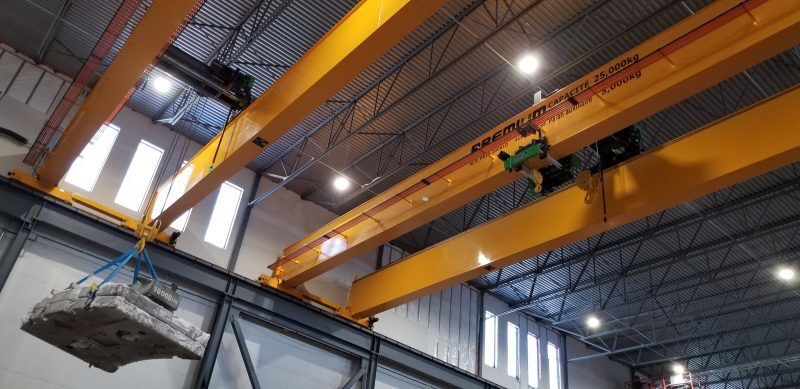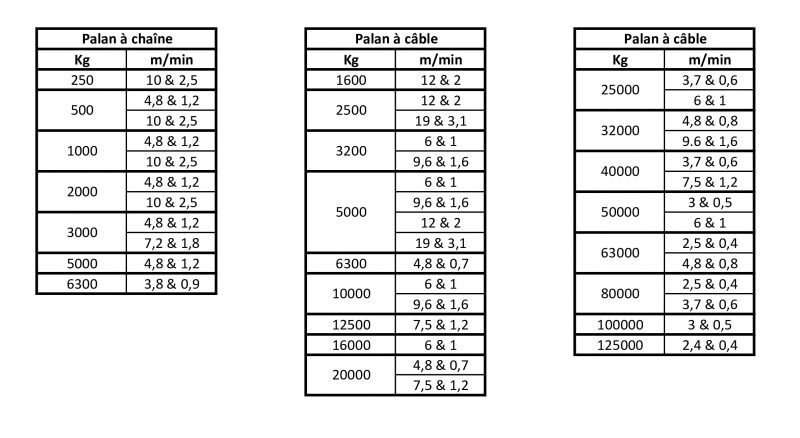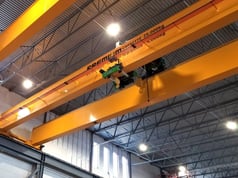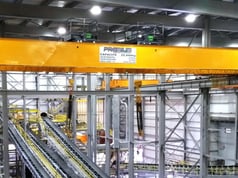-
PRODUCTSreturn
-
SERVICES AND PARTS
-
ABOUT US
Can I add a hoist to my overhead crane to speed up production?
6:42
What is the maximum lifting capacity you need? 15T, 20T or maybe more? You will then need equipment that matches that capacity. But if most of your lifts are for relatively light loads, will this equipment be fast enough for your operations to stay productive?
In today’s productivity context, is it possible to lift your heaviest loads while remaining fast with the rest of your lifting operations? When seeing the speed limits of high-capacity equipment, many customers ask us if it’s possible to add a 2nd hoist to their overhead crane girder to speed up the lifting of lighter loads (commonly known as an auxiliary hoist).
Premium has manufactured and sold hundreds of overhead cranes with 2 or more hoists. These configurations have been designed for different applications, such as tandem lifting. For more information on this type of application, please consult the article: What are the advantages of tandem lifting? However, many double-hoist overhead crane installations involved auxiliary hoists.
In this article, we will answer the following question:
- Can I install an additional hoist on my overhead crane?
- If so, how can I do it safely?
- What equipment speeds are available based on their capacity?
- What impact will the hook approach have?
2-hoist crane projects are quite common, but is it possible to install a 2nd hoist on an existing crane? Let’s start with this question.
Can a hoist be added to an existing overhead crane girder?
It’s perfectly possible to add a hoist to an existing overhead crane. However, there are a few steps to consider in this type of project. After all, your overhead crane was probably originally designed for a single hoist. Adding a hoist is therefore a major modification to your equipment, and in such circumstances, you need to follow the guidelines of current standards.
So how do you safely install an additional hoist on an overhead crane?
How do you safely install an additional hoist on an existing overhead crane?
When it comes to major modifications to lifting equipment, the first step is always engineering (CSA B167-16, 5.1.11). The next step is to make the necessary electrical modifications. Then, during installation, commissioning, including a load test, is required.
In fact, the steps are similar to those explained in the article “I’d like to replace my hoist”: 5 checks for your complete satisfaction. The main difference with a new hoist, apart from the fact that your current hoist will remain in place, is that new electrical components will certainly be required, which may involve adding wiring or a new electrical panel.
But some may say, can’t I simply increase the lifting speed of my current hoist to avoid buying a new one? Let’s answer this question while exploring lifting speeds by model.

What lifting speeds are available, based on their rated capacity?
Wire rope and chain hoists have different speeds, depending on the model. In general, the heavier the load the hoist can lift, the lower the speed. Although it is possible to increase the hoist’s speed, this would involve replacing major parts, such as the motor and gearbox, at considerable cost. What’s more, wear parts on a high-capacity hoist are more expensive. When you add up the cost of modifying the hoist and the subsequent maintenance costs, most buyers opt for an auxiliary hoist for daily lifting of lighter loads.
So, to help you decide on the right strategy, it’s useful to know the lifting speeds associated with the different capacities. The following tables give an overview of the lifting speeds available according to hoist capacity.
Available lifting speeds according to hoist rated capacity
The tables below refer to 2-speed hoists. Measurement units are in meters per minute. Speeds may vary according to the brand and model.

This information will give you an overview of the different lifting speeds and allow you to assess your needs depending on the loads to be lifted.
However, there’s another factor to consider. The impact of the hook approach when adding a 2nd hoist. What does this mean?
What will be the impact of the hook approach when adding a hoist to my overhead crane?
Adding a hoist to your overhead crane can boost the speed, but it can also mean a loss of approach distance. What does this mean?
Your current hoist can travel a certain distance at the ends of your overhead crane girder. You can then pick up parts with the hoist hook within this limit. This is called the approach.
However, by adding an auxiliary hoist, your main hoist won’t be able to travel as far on the girder on the side where your new hoist will be installed, as it will be blocked by it. Similarly, your auxiliary hoist will be blocked by your main hoist on the other side. There is therefore a loss of approach at both ends of the crane girder.

Auxiliary hoist under a girder
(without loss of hook approach)
(without loss of hook approach)

Auxiliary hoist independent from main hoist
(with loss of hook approach)
(with loss of hook approach)

Cart: Main and auxiliary hoist
(with loss of hook approach)
(with loss of hook approach)
For this reason, it’s important to think about your operations to ensure the best configuration and approach for your various lifts. To achieve this, what would be the next steps in adding a hoist to your overhead crane?
Where to start?
It is true that hoists for heavy loads are slower hoists for lighter loads. Since there’s no real advantage in increasing the speed of a hoist after it’s been commissioned, it may be necessary to add an auxiliary hoist to speed up the lifting of lighter parts. And this is entirely possible. If you follow the right steps, you’ll be able to complete your project safely and in compliance with current standards.
So how do you go about it? the first step is to contact a lifting specialist who will help you with the following elements already discussed :
- Validate your equipment engineering
- Analyze your application and operations to determine your needs in terms of capacity, speeds and hook approach
- Determine any electrical modifications and additions required
- Inform you about the next steps in your project
By doing so, you ensure that you add the right type of hoist to your existing overhead crane. A solution that’s right the first time, every time! If you need the assistance of one of our lifting specialists, please fill in the form at the bottom of this page. One of our experts will analyze your project with you and provide you with the hoist best suited to your needs.
Représentant technique chez Groupe Industriel Premium inc.
Learning Center
Whether you're an expert or know nothing about cranes, you'll find everything you need to know HERE.





